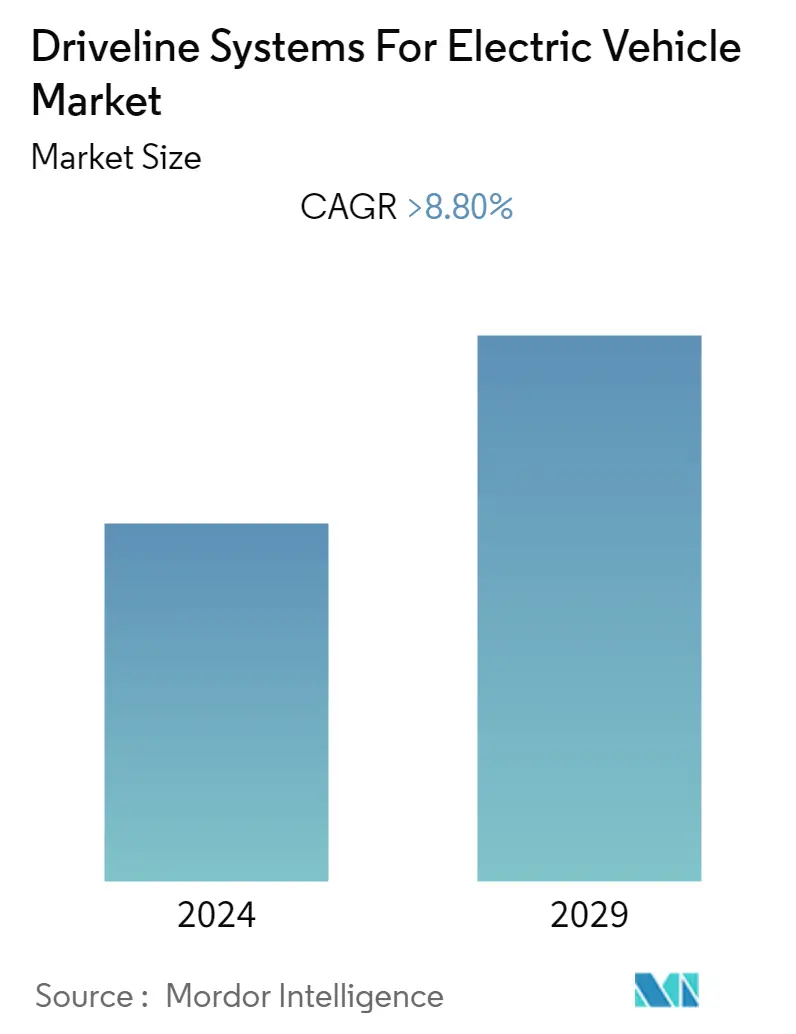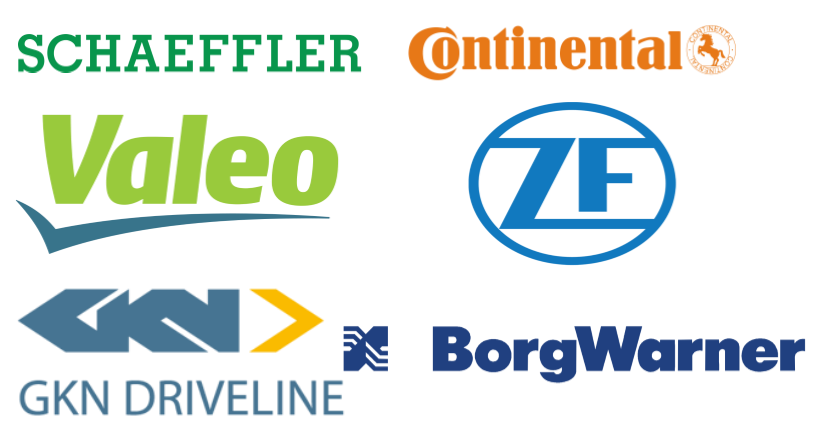
| Study Period | 2019 - 2029 |
| Base Year For Estimation | 2023 |
| Forecast Data Period | 2024 - 2029 |
| CAGR | 8.80 % |
| Fastest Growing Market | Asia Pacific |
| Largest Market | North America |
| Market Concentration | High |
Major Players
*Disclaimer: Major Players sorted in no particular order |
Electric Vehicle Driveline Market Analysis
The driveline systems for electric vehicles market is expected to register a CAGR of over 8.8%, during the forecast period, 2020-2025.
- The growth of the marketattributable to the favorable government policies, increasing incentives, declining lifetime cost of ownership, and falling battery prices. On the other hand, a major factor hindering the market growth is the higher cost of electric and hybrid driveline, when compared tothe conventional driveline.
- The developments and improvements in the AWD system and its penetration into the growing electric vehicles market are the other major factors that are anticipated to propel the growth of the market study during the forecast period.
- E-axles and differentials are used in a driveline as the end components, in orderto transmit motor power to wheels. E-axle reduces weight and improves the efficiency of electric vehicles. Although the market for e-axle is at a nascent stage, it is expected to attract attention among manufacturers in the future.
Electric Vehicle Driveline Industry Segmentation
The driveline systems for electric vehicle market has been segmented by architecture type, transmission type, motor type, drive type, vehicle type, and geography.
| Series |
| Parallel |
| Power Split |
| Automatic Transmission |
| Dual-clutch Transmission |
| Electric-continuously Variable Transmission |
| 45-100 kW |
| 100-250 kW |
| >250 kW |
| Hybrid Vehicles |
| Plug-in Hybrid Vehicles |
| Battery Electric Vehicles |
| Front Wheel Drive (FWD) |
| Rear Wheel Drive (RWD) |
| All Wheel Drive (AWD) |
| North America | United States |
| Canada | |
| Mexico | |
| Rest of North America | |
| Europe | United Kingdom |
| France | |
| Germany | |
| Rest of Europe | |
| Asia-Pacific | China |
| India | |
| Japan | |
| Rest of Asia-Pacific | |
| Rest of the World | Brazil |
| South Africa | |
| Other Countries |
Driveline Systems For Electric Vehicle Market Size Summary
The electric vehicle driveline market is poised for significant growth, driven by favorable government policies, increasing incentives, and advancements in technology. The declining lifetime cost of ownership and falling battery prices are further propelling this market expansion. However, the higher cost of electric and hybrid drivelines compared to conventional ones remains a challenge. The market is witnessing developments in all-wheel drive systems and the integration of e-axles and differentials, which enhance vehicle efficiency and reduce weight. Although the e-axle market is still emerging, it is expected to gain traction among manufacturers, contributing to the overall growth of the electric vehicle driveline sector.
The automotive industry is experiencing a shift towards automatic transmission systems, which have been gaining popularity since the 1980s due to their ease of use. Technological advancements have led to the introduction of multiple-speed transmissions, with nine and ten-speed models emerging recently. This trend is expected to continue as automakers strive to meet fuel economy standards and enhance driveline systems. North America leads in demand for automatic transmission systems, prompting manufacturers to expand production capacities. The electric vehicle market's growth, supported by regulatory norms and government initiatives, is increasing the demand for advanced driveline systems. Major players in the industry are investing in research and development to meet the rising demand for lightweight and high-efficiency solutions, ensuring a promising future for electric vehicles and their driveline systems.
Driveline Systems For Electric Vehicle Market Size - Table of Contents
1. MARKET DYNAMICS
-
1.1 Industry Attractiveness - Porter's Five Forces Analysis
- 1.1.1 Threat of New Entrants
- 1.1.2 Bargaining Power of Buyers/Consumers
- 1.1.3 Bargaining Power of Suppliers
- 1.1.4 Threat of Substitute Products
- 1.1.5 Intensity of Competitive Rivalry
- 1.2 Market Drivers
- 1.3 Market Restraints
2. MARKET SEGMENTATION
-
2.1 Architecture Type
- 2.1.1 Series
- 2.1.2 Parallel
- 2.1.3 Power Split
-
2.2 Transmission Type
- 2.2.1 Automatic Transmission
- 2.2.2 Dual-clutch Transmission
- 2.2.3 Electric-continuously Variable Transmission
-
2.3 Motor Type
- 2.3.1 45-100 kW
- 2.3.2 100-250 kW
- 2.3.3 >250 kW
-
2.4 Vehicle Type
- 2.4.1 Hybrid Vehicles
- 2.4.2 Plug-in Hybrid Vehicles
- 2.4.3 Battery Electric Vehicles
-
2.5 Drive Type
- 2.5.1 Front Wheel Drive (FWD)
- 2.5.2 Rear Wheel Drive (RWD)
- 2.5.3 All Wheel Drive (AWD)
-
2.6 Geography
- 2.6.1 North America
- 2.6.1.1 United States
- 2.6.1.2 Canada
- 2.6.1.3 Mexico
- 2.6.1.4 Rest of North America
- 2.6.2 Europe
- 2.6.2.1 United Kingdom
- 2.6.2.2 France
- 2.6.2.3 Germany
- 2.6.2.4 Rest of Europe
- 2.6.3 Asia-Pacific
- 2.6.3.1 China
- 2.6.3.2 India
- 2.6.3.3 Japan
- 2.6.3.4 Rest of Asia-Pacific
- 2.6.4 Rest of the World
- 2.6.4.1 Brazil
- 2.6.4.2 South Africa
- 2.6.4.3 Other Countries
Electric Vehicle Driveline Market Research FAQs
What is the current Driveline Systems For Electric Vehicle Market size?
The Driveline Systems For Electric Vehicle Market is projected to register a CAGR of greater than 8.8% during the forecast period (2025-2030)
Who are the key players in Driveline Systems For Electric Vehicle Market?
GKN Driveline (Melrose Industries PLC), Schaeffler Technologies AG & Co. KG, BorgWarner Inc., ZF Friedrichshafen AG and Continental AG are the major companies operating in the Driveline Systems For Electric Vehicle Market.


